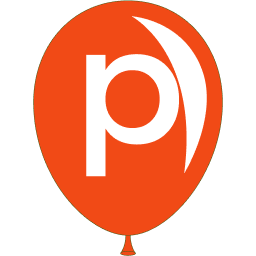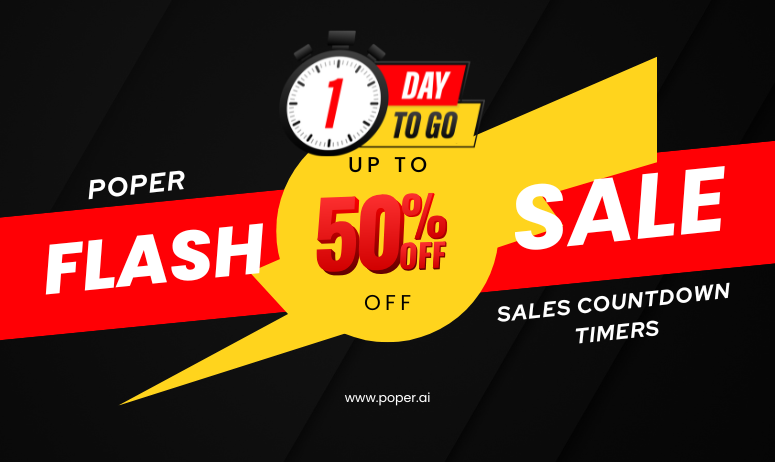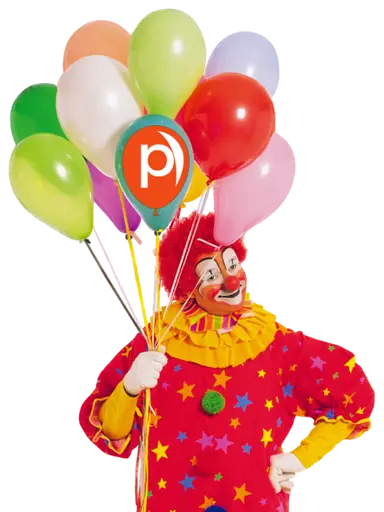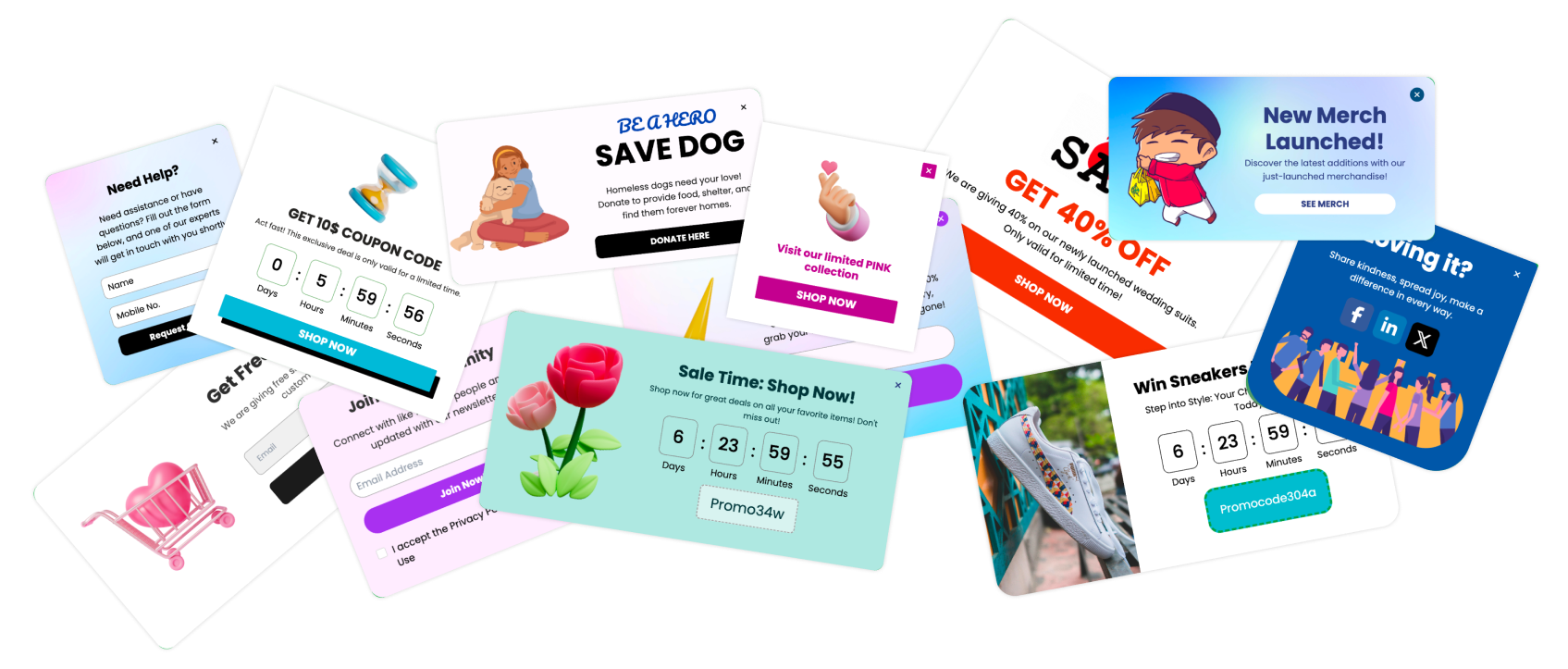Urgency makes people act. Countdown timers make urgency visible.
Sales countdown timers are real-time visual elements placed on websites or within popups that show the time remaining for a specific deal, offer, or event. Whether it’s a flash sale, webinar signup, product launch, or seasonal offer, countdown timers serve as a psychological nudge, driving users to act before it’s "too late."
Humans are hardwired to respond to urgency. When users see that time is running out, it triggers a fear of loss—an emotional response deeply tied to our survival instincts. This concept, known as loss aversion, makes users more likely to act immediately when faced with a ticking clock.
Scarcity + Urgency = Action
Countdown timers work because they shorten decision windows and intensify the perceived value of an offer.
People prefer to buy quickly rather than miss out entirely.
Why Countdown Timers Work in Sales and Marketing
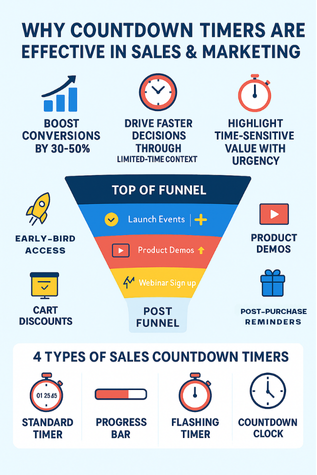
Boost Conversions: Adding a timer to your sales page or popup can increase conversions by up to 30–50%, according to industry tests.
Drive Faster Decisions: Timers reduce hesitation by creating a limited-time context.
Highlight Time-Sensitive Value: They signal urgency in a way that’s easy to understand at a glance.
Where Countdown Timers Fit in the Funnel
| Funnel Stage | Countdown Strategy | Purpose |
|---|---|---|
| Top of Funnel | Launch events, early-bird access | Create buzz |
| Mid-Funnel | Product demos, webinar registration | Convert interest to action |
| Bottom Funnel | Cart discounts, flash sales, upsell offers | Close the deal |
| Post-Purchase | Loyalty campaigns, future deal reminders | Encourage repeat purchases |
Countdown timers work across every stage of the funnel—from attracting users to closing sales and even retaining them.
4 Types of Sales Countdown Timers (MECE Classification)
When it comes to sales countdown timers, not all are created equal. Different types serve different psychological and strategic purposes. Here’s a breakdown of the four most effective and widely used timer types in modern digital marketing.
1. Evergreen Timers (User-Based)

Evergreen countdown timers are unique to each visitor. They start ticking when the user first visits your page or sees a popup—regardless of the day or time.
Use Case: Ideal for email funnels, lead magnets, and automated onboarding sequences.
Why It Works:
Creates urgency for each user, no matter when they arrive
Feels personal and time-sensitive
Great for evergreen offers and limited-time lead nurturing
Example: “You have 15 minutes to claim your free bonus. Don’t miss out!”
2. Fixed Date Timers (Global End Time)
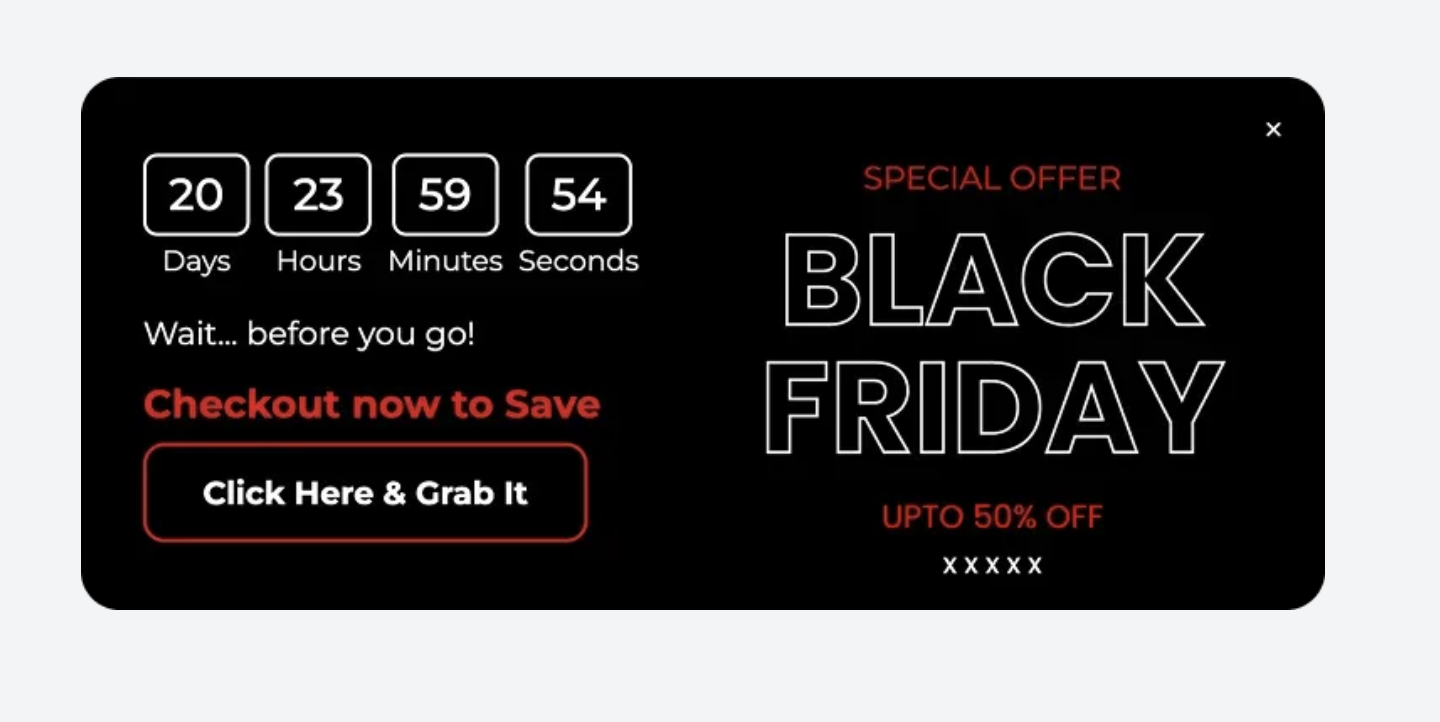
These timers are set to a fixed deadline, like “Offer ends on August 31 at midnight.” Every user sees the same countdown, regardless of when they enter.
Use Case: Product launches, Black Friday campaigns, webinars
Why It Works:
Creates global anticipation
Aligns with large campaigns and fixed sales windows
Great for limited inventory or time-sensitive events
3. Looping Timers (Recurring Offers)
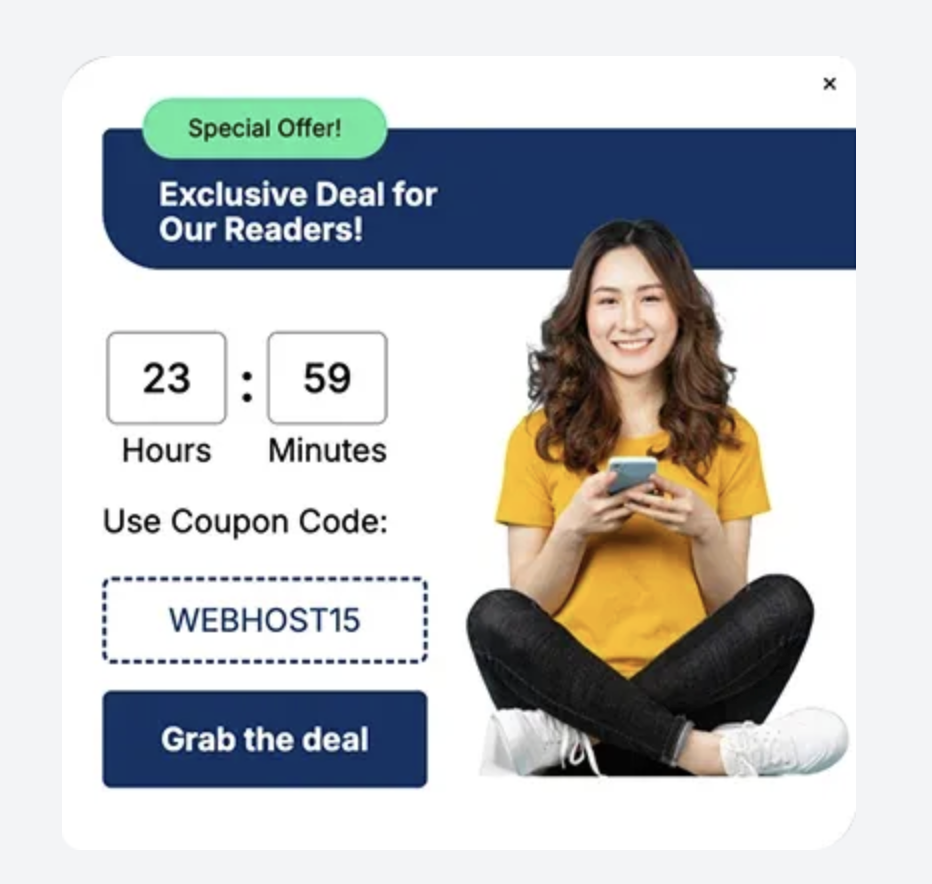
Looping countdown timers reset after a specific period—daily, weekly, or monthly—giving the impression of recurring scarcity.
Use Case: Daily deals, flash sales, loyalty incentives
Why It Works:
Drives action from returning visitors
Keeps urgency fresh without adding complexity
Good for subscription-based or high-volume e-commerce
Caution: Avoid making it feel “fake” by aligning your messaging transparently.
4. Real-Time Stock or Quantity Countdown
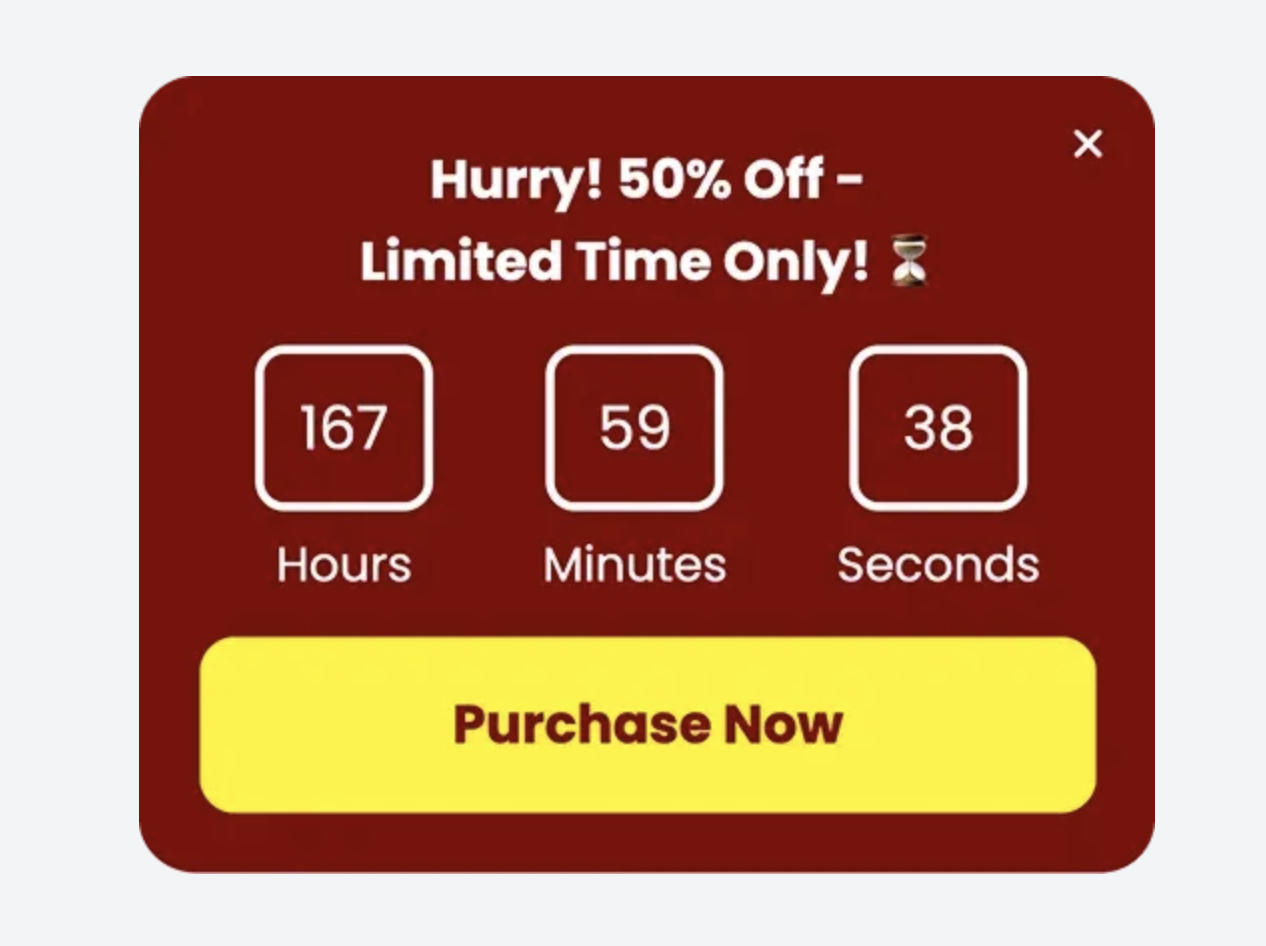
These aren't just timers—they show live inventory, such as "Only 3 seats left!" or “23 people have this in their cart.”
Use Case: Limited product stock, high-demand sales, service slots
Why It Works:
Combines scarcity + urgency + social proof
Encourages fast action due to perceived popularity
Useful for high-conversion checkout flows
Evergreen Timers
How Evergreen Timers Work
Evergreen countdown timers start ticking down for each individual user the moment they visit your site or trigger a popup. Unlike fixed-date timers that end on a global deadline, evergreen timers are personalized. They create a unique sense of urgency that feels authentic—because it is.
Behind the scenes, the timer is triggered based on:
First visit timestamp
Cookie/session data
Popup display event (scroll, click, exit intent)
Once the timer expires, you can:
Redirect them to a different page
Show an “expired offer” message
Remove the offer altogether
This is perfect for lead capture, email drip campaigns, or limited-time deals that don’t require hard deadlines.
Best Use Cases for Evergreen Timers
Evergreen timers are ideal when you want urgency without depending on a calendar. Here are top scenarios:
| Use Case | Why It Works |
|---|---|
| Lead Magnets | Increases opt-in rates by adding urgency to free downloads |
| Email Funnels | Aligns perfectly with automated campaigns |
| Sales Funnels | Creates pressure in multi-step checkout flows |
| Webinar Replays | Encourages timely viewing before “replay expires” |
| Upsell Offers | Nudges users with urgency right after initial purchase |
Pros and Cons of Evergreen Timers
Pros:
✅ Feels personalized and relevant
✅ Perfect for automation and evergreen sales
✅ Doesn’t require manual campaign scheduling
✅ High-converting for first-time visitors
Cons:
❌ Requires user tracking (via cookies/session data)
❌ Can feel “fake” if not implemented authentically
❌ Less effective for broad promotions or events
How to Set Up Evergreen Timers in Poper
With Poper, you can easily set up evergreen timers inside:
Popups
Sticky bars
Full-screen overlays
Embedded elements
Here’s how it works:
Choose your campaign type (e.g. discount popup)
Select the “Evergreen Timer” block from template
Set duration (e.g. 15 minutes, 24 hours, 7 days)
Decide what happens when the timer ends (redirect, hide, show different message)
Launch it live and track performance via Poper Analytics
Fixed Date Timers
Launch Countdown for Sales & Events
Fixed date timers are deadline-based timers that count down to a specific date and time. Unlike evergreen timers, every user sees the same timer ticking toward the same event—creating a unified sense of urgency across your entire audience.
These timers are perfect for:
Product launches
Live webinars
Sales events
Event registrations
Public holidays or big promos (e.g., Black Friday)
Why it works:
Fixed deadlines create a collective urgency that’s easy to promote across email, social, and paid campaigns. They set a firm expectation—the offer ends for everyone at the same time.
Holiday and Seasonal Campaigns
During holidays, consumers expect urgency. Fixed-date timers tap into that seasonal energy and amplify it.
Imagine landing on a homepage during Diwali or Christmas and seeing:“🎉 Diwali Mega Offer ends in 3 days!”
Here’s what makes them powerful:
Reinforces campaign consistency across channels
Works exceptionally well with limited-edition or seasonal bundles
Boosts impulse buying behavior
Poper Tip: Use fixed-date timers in homepage banners or exit-intent popups during Black Friday, New Year, Independence Day, etc.
End-of-Month/Quarter Offers
End-of-period sales are natural fits for fixed timers:
Monthly subscription promos
Quarterly revenue pushes
B2B SaaS limited-time upgrades
Why it’s effective:
Encourages fence-sitters to make decisions before time runs out
Adds accountability on your internal sales team while motivating users
Syncs well with CRM deadlines and lifecycle automations
How to Build Fixed Date Timers with Poper
Poper lets you launch fixed date countdowns in 3 easy steps:
Choose the "Fixed Date Timer" option inside any popup or widget template
Set your end time (e.g. July 31, 11:59 PM IST)
Customize design (colors, fonts, animation)
Define post-timer behavior: auto-close, change message, or redirect
Bonus: You can segment visibility based on traffic source, device, user status (new/returning), and more!
Looping Countdown Timers
Creating Perceived Urgency Every Week/Day
Looping countdown timers are recurring timers that reset automatically on a regular schedule—daily, weekly, or monthly. Unlike evergreen timers (which are user-based) and fixed-date timers (which expire once), looping timers keep your urgency alive all the time.
These timers are incredibly useful for:
Daily flash sales
Weekly offers
Time-bound loyalty rewards
Recurring live sessions or community events
Best Practices for Repeating Timers
Here’s how to get the most out of looping countdown timers:
| Best Practice | Why It Matters |
|---|---|
| Be Transparent | Let users know this deal resets regularly—avoid deception |
| Align with Natural Timeframes | Daily or weekly loops feel more natural |
| Use Dynamic Messaging | Vary your offer or product to prevent fatigue |
| Pair with Scarcity | Add “limited stock” or “only 50 codes/day” for urgency |
Messaging Examples:
“⏰ Today’s Flash Deal resets at midnight!”
“🎁 New deal every 24 hours—grab today’s reward before it’s gone!”
How to Set Looping Timers in Poper
Poper makes setting up looping timers effortless.
Select your timer block inside any popup or embed
Choose “Recurring Countdown” and set your interval (24h, 7d, etc.)
Add optional logic like:
- Show only between 9am–9pm
- Hide on weekends
- Trigger based on scroll or inactivity
Show only between 9am–9pm
Hide on weekends
Trigger based on scroll or inactivity
Launch and monitor performance inside the analytics dashboard
Stock-Based Countdown Elements
Showing Product Quantity Left
Stock-based countdown elements display the remaining quantity of a product, seat, or service slot—often paired with a visual countdown or urgency message.
These counters simulate real-world pressure and trigger what’s known as FOMO—the Fear of Missing Out.
Why It Works:
Scarcity is one of the most powerful cognitive triggers in consumer behavior
Taps into the idea that others want what we’re considering, making it more desirable
Reduces time spent comparing alternatives—users act faster
Dynamic Scarcity with Real Inventory Data
There are two ways to implement stock-based elements:
| Method | Description | Example |
|---|---|---|
| Static Scarcity | You manually set a number, like “Only 5 left” | Great for urgency popups or marketing pages |
| Dynamic Scarcity | Real-time sync with inventory or database | Perfect for eCommerce product pages and live webinars |
FOMO and Buyer Psychology
When visitors see that something is selling out or that others are already buying, it creates an internal tension:
“If I wait, I might miss this completely.”
Here’s how stock-based elements psychologically influence users:
Fear of regret (loss aversion) kicks in
Perceived value increases with limited availability
Social proof makes the product feel popular and validated
Reduced decision time—users act faster to secure their spot
✅ According to a study by CXL, showing real-time stock levels increased conversion rates by up to 17.8% in high-traffic eCommerce stores.
How to Use Stock Countdown with Poper
Poper lets you simulate or connect stock scarcity elements into popups, banners, or embedded widgets.
You can:
Manually set "X items left" in custom campaigns
Trigger low-stock alerts based on behavior (e.g., if user hesitates at cart)
Combine with exit-intent and cart abandonment strategies
A/B test with vs. without stock count
Bonus: Soon, Poper will integrate with inventory APIs for real-time product sync.
Where to Place Countdown Timers on Your Site
Placing countdown timers strategically can make the difference between a mild nudge and a high-converting push. Below are the five most effective locations across the customer journey.
Homepage Timers
Your homepage is your storefront. If you're running a limited-time promotion or launching a big campaign, this is your first impression.
Best practices:
Add a full-width countdown banner at the top (above-the-fold)
Use bright colors and large numbers for visibility
Pair with strong copy like “3 Days Only” or “Ends Tonight!”
Product Pages
This is where interest turns into consideration. Adding a countdown timer on your product page can tip the scales.
High-converting ideas:
Stock-based countdowns: “Only 5 left!”
Time-based urgency: “Buy within the next 15 minutes to get 10% off”
Shipping cutoffs: “Order within 03:25:44 for same-day dispatch”
Cart and Checkout Pages
This is where urgency matters the most—right before a user is about to abandon or decide.
Best use cases:
“Your reserved items will expire in 10:00”
“This discount disappears at midnight”
Add timers on both cart page and checkout confirmation
Result:
These timers push indecisive users to act now and reduce cart abandonment.
Popups and Sticky Bars
Popups and sticky bars are versatile and highly visible—perfect for countdown implementation.
With Poper, you can show countdowns:
On exit-intent (as a final offer)
After X seconds of scroll time
Only on mobile or specific traffic sources
In sticky format (always visible at the top or bottom)
Example:
“Wait! 🔥 Complete your purchase in the next 09:58 to unlock free shipping.”
Email and Landing Pages
Don’t limit countdowns to your website. You can embed timers in email campaigns and standalone landing pages to drive urgency from off-site sources.
Why it works:
Boosts CTR by promising time-sensitive value
Keeps users focused on a single action
Works exceptionally well with evergreen webinars, flash sales, and lead magnet expiration
Countdown Timer Design Best Practices
“Design isn’t just what it looks like and feels like. Design is how it works.” — Steve Jobs
A countdown timer is only as effective as its visibility and design. Even a perfectly timed offer can flop if the timer is overlooked, poorly styled, or not mobile-friendly. Let’s break down the four essential design pillars that make countdown timers convert.
Minimal vs. Bold Designs
Minimal timers blend seamlessly with your website’s UI. They don’t scream, but they still say “look at me.”
Bold timers, on the other hand, command attention—great for promotions or flash sales.
| Style | Best For | Characteristics |
|---|---|---|
| Minimal | SaaS, Professional Sites | Clean font, neutral colors, subtle tones |
| Bold | E-commerce, Sales Events | Bright colors, large numbers, animations |
Mobile Optimization
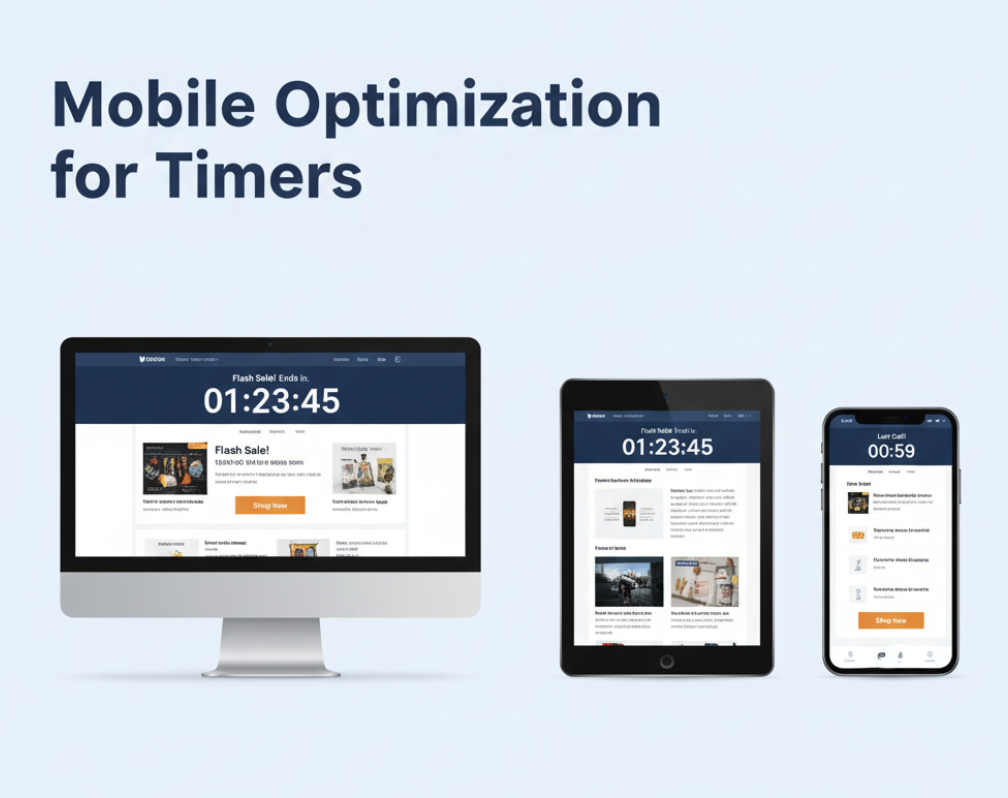
With over 60% of web traffic coming from mobile, your timer must look great on smaller screens.
Mobile-friendly checklist:
Use responsive design (scales well on all devices)
Avoid timers that overlap CTA buttons or disrupt UX
Test across iOS and Android, especially for popups
Ensure timers are large enough to read without zooming
Poper’s templates automatically adapt across screen sizes, ensuring pixel-perfect timers on mobile, tablet, and desktop.
Animation and Movement for Visibility
Static timers are fine—but animated timers grab attention faster and hold it longer.
Smart animation ideas:
Pulse effect as the timer approaches zero
Flip-clock animation (adds urgency + retro feel)
Progress bar countdowns (great for sticky bars)
⚠️ Don’t overdo it. Keep movement subtle and purposeful. Too much animation = distraction.
Using Color Psychology for Urgency
Colors influence action. The right palette can dramatically improve your timer’s effectiveness.
| Color | Psychological Trigger | Use For |
|---|---|---|
| 🔴 Red | Urgency, Danger, Action | Flash sales, Last-minute offers |
| 🟠 Orange | Excitement, Aggression | Daily deals, Mid-funnel offers |
| 🟢 Green | Security, Trust, Go | Payment pages, Signup forms |
| 🔵 Blue | Calm, Control | SaaS, B2B timers |
| ⚫ Black | Exclusivity, Luxury | High-end product promos |
Example:
“🚨 Only 1 Hour Left!” in bold red on a white sticky bar = instant attention.
Quick Timer Design Checklist
Clear, legible font
Contrasting background
Mobile-responsive layout
Purposeful animation (if any)
Strong CTA near the timer
Message aligned with timer (e.g., “Hurry! Ends in…”)
Countdown Timers for Different Business Models
While the psychology of urgency is universal, how you apply countdown timers should vary by context. Here’s how to tailor timer usage for four major business types.
E-Commerce
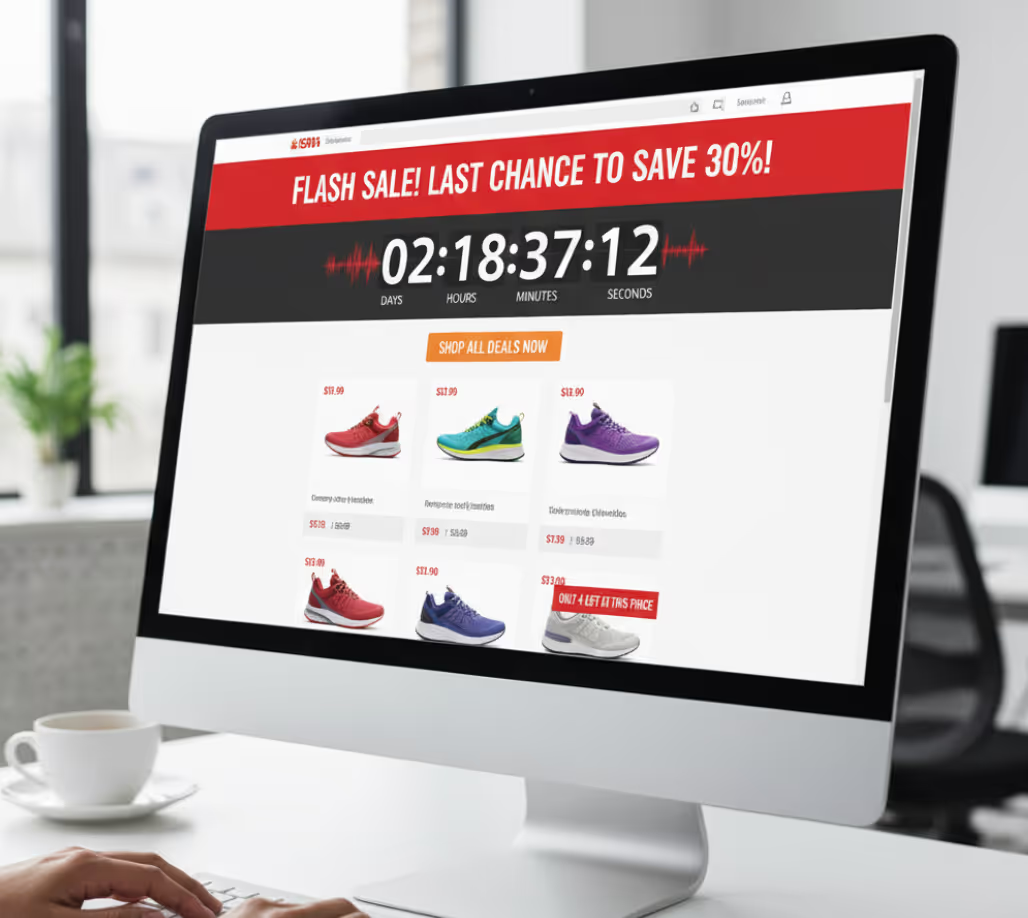
In e-commerce, countdown timers can literally make or break a sale—especially when it comes to limited stock or time-sensitive deals.
Top Timer Use Cases:
Flash sales (e.g., “Only 3 hours left to save 30%!”)
Cart abandonment popups (e.g., “Your cart expires in 10:00”)
Product scarcity (e.g., “Only 4 items left at this price!”)
Holiday or seasonal campaigns
SaaS (Software-as-a-Service)
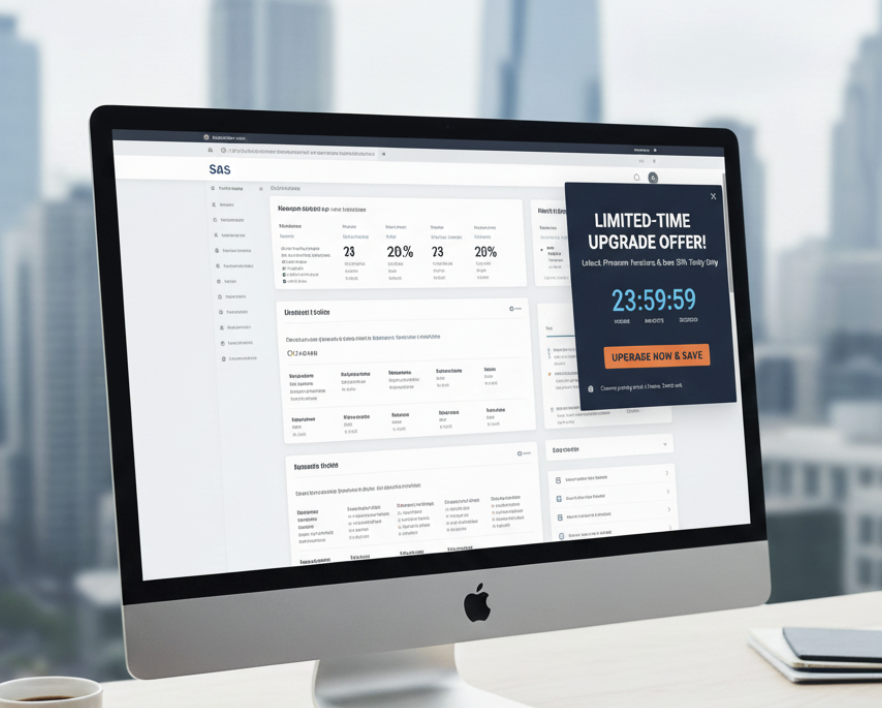
For SaaS companies, countdown timers are all about trial-to-paid conversion and feature upgrades.
Effective Timer Applications:
Limited-time upgrade offers (“Upgrade in 24 hours for 20% off”)
Early bird discounts for new product launches
Webinar signups or replays with expiration
Deadline-driven pricing changes (“Current pricing ends in X”)
Online Courses & Events
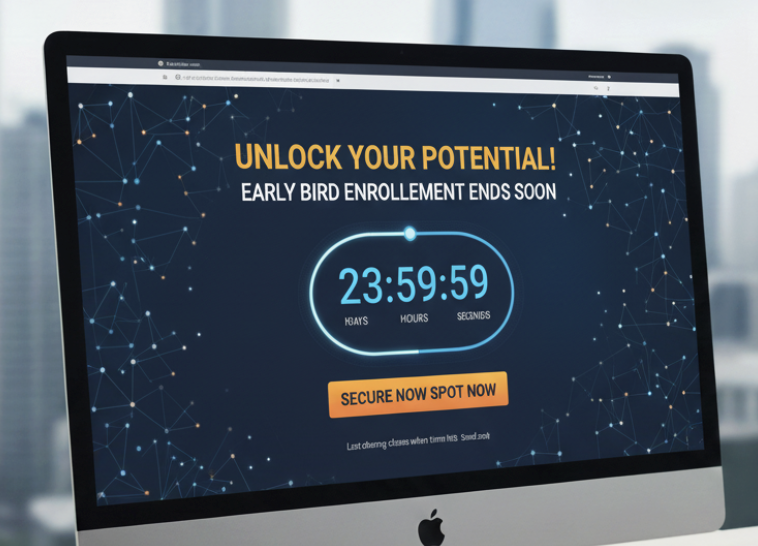
If you’re selling digital products or running events, timing is everything. Deadlines create commitment—which drives conversions.
High-Impact Countdown Use Cases:
Course enrollment deadlines
Limited access to early bird pricing or bonus modules
Replays of live webinars (“Replay expires in 48h”)
Seat limitations for live cohorts
Lead Magnets and Opt-ins
If your business is focused on generating leads, countdown timers help push users over the edge when they’re on the fence.
Use Cases for Timers:
Limited-time lead magnet access (“Free checklist expires in 15:00”)
Bonus unlocks (“Join in the next hour and get 2 extra templates”)
Urgency popups on blog posts or content hubs
Exit popups on high-value articles with countdowns
Poper and Countdown Timers
At Poper, we’ve built countdown timers not as a side feature, but as a core conversion engine for modern marketers. Whether you're running a flash sale, an early bird campaign, or simply trying to reduce bounce rate — Poper makes it ridiculously easy to launch high-performing countdowns, even if you’re not technical.
How Poper Supports Countdown Popups
With Poper, you can create no-code countdown popups that trigger at the perfect moment — like when a visitor is about to leave, spends a certain amount of time on the site, or visits a specific page.
You can:
Choose from multiple timer types: evergreen, fixed-date, looping
Set up real urgency-based conditions: scroll %, exit intent, inactivity
Add timers into popups, sticky bars, in-page embeds, and banners
Preview and launch instantly — without touching your website code
Summary: Countdown Timers as a Growth Lever
Countdown timers are more than just clocks — they’re conversion accelerators.
When powered by empathy, design, data, and the right tool (like Poper), they become one of the highest-ROI features in your marketing stack.
So if you're ready to stop losing sales to hesitation — it’s time to add real urgency to your site.
FAQs: Countdown Timers
What is the ideal length for a countdown timer?
It depends on the goal. Short timers (5–15 minutes) work well for exit popups or cart abandonment, while longer ones (24–72 hours) suit sales campaigns. For evergreen funnels, 20–60 minutes usually creates the right balance between urgency and realism.
Can countdown timers really increase sales?
Yes. When used properly, they trigger urgency and help users make faster decisions. Brands often see higher conversion rates, especially when timers are combined with real deadlines or limited-time offers. Poper users have reported significant boosts in conversions with well-timed countdowns.
Are timers effective for B2B sites?
They are — if done thoughtfully. Instead of discounts, use timers for limited-time access to reports, consultations, or webinars. B2B buyers respond better to time-sensitive value, not pressure tactics.
How do I use countdown timers with Poper?
Just pick a format (popup, bar, embed), choose timer type (fixed or evergreen), and set smart triggers like scroll, delay, or exit intent. No code needed. You can launch, test, and optimize everything from one dashboard.
Can I use countdown timers without being spammy?
Definitely. Use honest deadlines, avoid fake resets, and explain why the offer is time-limited. When urgency is real and respectful, it builds trust — not frustration. Poper helps you stay ethical while still converting better.
